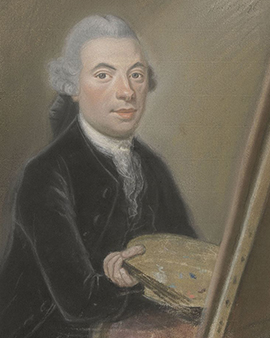The style of the artist Jan van Os, a Dutch painter of the 18th century, can be compared with the flower painting of Jan van Huysum. He entered the visual arts scene as a phoenix of flower and fruit painters and was already active a full century earlier. The rich flower arrangements of both painters merge in colour to form a masterpiece, which is often enriched with fruit components. Jan van Os learned his art at the master school of Aert Schouman and studied there from 1710 to 1721. While the still young painter initially felt an affinity for the seascapes, his interest was influenced in the years that followed by his turn to flora. Ultimately it was these motifs that gave his artist name an international reputation. Another passion of this exceptional artist was writing poems and plays.
As a member of the artists' association Confrerie Pictura, the brotherhood of painting in The Hague, the emphasis was undoubtedly on mutual encouragement and consolidation of relations with one another. This forerunner of the Royal Academy of Fine Arts of professional painters from the Netherlands was also used as an obligatory part of their work show. While Jan von Os devoted himself increasingly to floral arrangements, these must by no means be attributed exclusively to a decorative idea of nature. Rather, symbols similar to the vanitas motif are in the foreground here. Props for the still life must therefore always be considered individually and as a whole. In this context, symbols of earthly existence, such as books, money or other treasures, are juxtaposed with those of transience. The flower as a form of life, and thus represented in its full bloom, can be interpreted as a pleasure that transience meets with decay. In this respect, a third group of symbols, such as ears of grain, for example, reflects rebirth.
While the background can be made dark and light, it is noticeable that the artist Jan van Os devotes melancholy to only a few paintings. The black emptiness symbolized by the vanitas motif is hardly ever present in his paintings, which live from the lightness of different seasons. His light flower and fruit arrangements thus always use a colour of the cover as a background, which, as in the example of the painting "Still Life with Fruit and Flowers", traces the grape green of the grape. Even in the darker motifs, life and death are represented together, creating a relaxed atmosphere. It is the subtleties of the fauna and flora that ultimately make each motif unique and made the poet famous among visual artists in Germany, France and England. Jan von Os was married to the deaf-mute portrait painter Susanna de la Croix, with whom he had seven children. Only three sons and one daughter reached adulthood.
×





.jpg)
.jpg)
.jpg)
.jpg)
.jpg)
.jpg)
.jpg)
.jpg)
_Collecti_-_(MeisterDrucke-1641151).jpg)
_Collecti_-_(MeisterDrucke-1641151).jpg)
.jpg)
.jpg)
.jpg)
.jpg)
.jpg)
.jpg)
.jpg)
.jpg)
.jpg)
.jpg)
.jpg)
.jpg)
_-_(MeisterDrucke-312183).jpg)
_-_(MeisterDrucke-312183).jpg)
.jpg)
.jpg)
 - (MeisterDrucke-44194).jpg)
 - (MeisterDrucke-44194).jpg)
.jpg)
.jpg)
.jpg)
.jpg)
.jpg)
.jpg)
.jpg)
.jpg)
.jpg)
.jpg)
.jpg)
.jpg)
.jpg)
.jpg)
.jpg)
.jpg)
.jpg)
.jpg)
.jpg)
.jpg)
.jpg)
.jpg)
.jpg)
.jpg)
.jpg)
.jpg)
_-_(MeisterDrucke-1466066).jpg)
_-_(MeisterDrucke-1466066).jpg)
_18eme_siecle_Musee_P_-_(MeisterDrucke-1322927).jpg)
_18eme_siecle_Musee_P_-_(MeisterDrucke-1322927).jpg)
.jpg)
.jpg)
_-_(MeisterDrucke-1111339).jpg)
_-_(MeisterDrucke-1111339).jpg)
.jpg)
.jpg)
_18th_century_Sun_052_X_073_m_-_(MeisterDrucke-981858).jpg)
_18th_century_Sun_052_X_073_m_-_(MeisterDrucke-981858).jpg)
.jpg)
.jpg)
.jpg)
.jpg)
.jpg)
.jpg)
_-_(MeisterDrucke-1111592).jpg)
_-_(MeisterDrucke-1111592).jpg)
_-_(MeisterDrucke-1471826).jpg)
_-_(MeisterDrucke-1471826).jpg)
.jpg)
.jpg)
.jpg)
.jpg)
.jpg)
.jpg)
.jpg)
.jpg)
.jpg)
.jpg)
.jpg)
.jpg)
.jpg)
.jpg)
.jpg)
.jpg)
.jpg)
.jpg)
.jpg)
.jpg)
.jpg)
.jpg)






